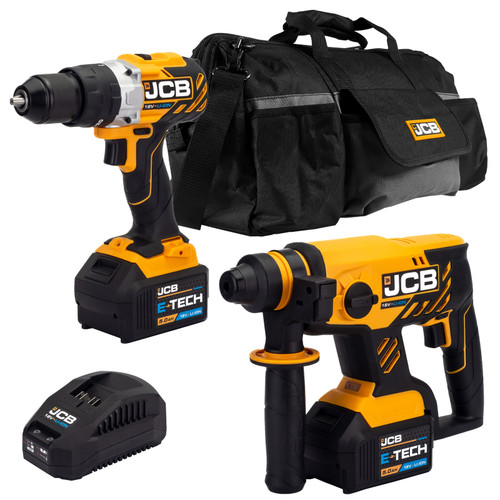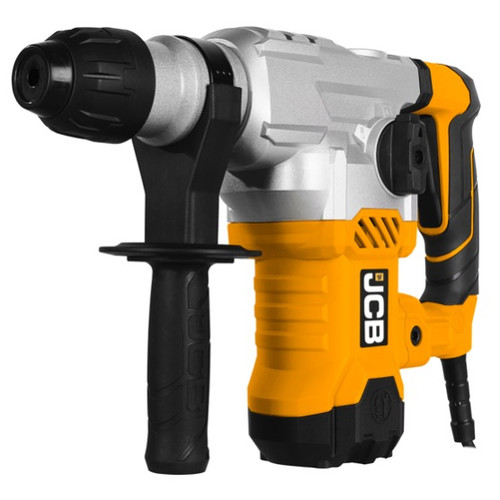-
 Add to Cart
Add to CartJCB 18V 1.7J SDS Rotary Hammer Drill, 5.0Ah Li-ion Battery, 2.4Ah Charger, 4x SDS Bits, Keyless and SDS Plus Chuck
£169.99 (Inc. VAT)£141.66 (Ex. VAT) -
 Add to Cart
Add to CartJCB 18V 1.7J SDS Rotary Hammer Drill, 4.0Ah Li-ion Battery & 2.4Ah Charger Kit, 4x SDS Bits, Keyless and SDS Plus Chuck
£159.99 (Inc. VAT)£133.32 (Ex. VAT) -
 Add to Cart
Add to CartJCB 18V 1.7J SDS Rotary Hammer Drill, 3.0Ah Li-ion Battery & 2.4Ah Charger Kit, 4x SDS Bits, Keyless and SDS Plus Chuck
£154.99 (Inc. VAT)£129.16 (Ex. VAT) -
 Add to Cart
Add to CartJCB 18V 1.7J SDS Rotary Hammer Drill, 2.0Ah Li-ion Battery & 2.4Ah Charger Kit, 4x SDS Bits, Keyless and SDS Plus Chuck
£144.99 (Inc. VAT)£120.82 (Ex. VAT) -
 Add to Cart
Add to CartJCB 18V 1.7J SDS Rotary Hammer Drill & 5.0Ah Li-ion Battery, 4x SDS Bits, Keyless and SDS Plus Chuck
£149.99 (Inc. VAT)£124.99 (Ex. VAT) -
 Add to Cart
Add to CartJCB 18V 1.7J SDS Rotary Hammer Drill, 4.0Ah Li-ion Battery, 4x SDS Bits, Keyless and SDS Plus Chuck
£139.99 (Inc. VAT)£116.66 (Ex. VAT) -
 Add to Cart
Add to CartJCB 18V 1.7J SDS Rotary Hammer Drill and 3.0Ah Li-ion Battery Kit, 4x SDS Bits, Keyless and SDS Plus Chuck
£134.99 (Inc. VAT)£112.49 (Ex. VAT) -
 Add to Cart
Add to CartJCB 18V 1.7J SDS Rotary Hammer Drill & 2.0Ah Li-ion Battery Kit, 4x SDS Bits, Keyless and SDS Plus Chuck
£124.99 (Inc. VAT)£104.16 (Ex. VAT) -
 CHOOSE OPTIONS
CHOOSE OPTIONSJCB 18V 1.7J Brushless SDS Rotary Compact Hammer Drill, 2-5Ah Li-ion Battery, 4x SDS Bits, Keyless and SDS Plus Chuck | 21-18BLRH-B
£94.99 - £149.99 (Inc. VAT)£79.16 - £124.99 (Ex. VAT) -
 Add to Cart
Add to CartJCB 18V Brushless Combi Drill & Hammer Drill SDS Kit, 2x 5.0ah Li-Ion Batteries, Charger, 20" Kit Bag | 21-18BLTPKSDS-5
£259.99 (Inc. VAT)£216.66 (Ex. VAT) -

JCB 18V Brushless Combi Drill, Impact Driver & Hammer Drill Kit, 2 x 2Ah Li-Ion Batteries, Charger and 26'' Kit Bag | 21-18BL3PK-2
£279.99 (Inc. VAT)£233.32 (Ex. VAT) -

JCB 18V Brushless Combi Drill, Impact Driver & Hammer Drill Kit, 2 x 5Ah Li-Ion Batteries, Charger and 26'' Kit Bag| 21-18BL3PK-5
£314.99 (Inc. VAT)£262.49 (Ex. VAT) -
 Add to Cart
Add to CartJCB 18V Brushless Rotary Hammer Drill Kit SDS 5Ah Lithium-Ion Battery and Charger in 20" Kit Bag | 21-18BLRH-5X-BG
£182.99 (Inc. VAT)£152.49 (Ex. VAT) -
 Add to Cart
Add to CartJCB 1500W 6J Corded SDS Plus Rotary Hammer Drill, Anti-Vibration Handle, 3m Cable | 21-RH1500
£99.99 (Inc. VAT)£83.32 (Ex. VAT) -
 Add to Cart
Add to CartJCB 1050W 3.5J Corded SDS Rotary Hammer Drill, Variable Speed, 4 Mode, 3m Cable | 21-RH1050
£79.99 (Inc. VAT)£66.66 (Ex. VAT)
 Expert Advice and Aftersales
Expert Advice and Aftersales
 Free UK Delivery*
Free UK Delivery*
 Pay with Klarna
Pay with Klarna

 In stock to buy today
In stock to buy today